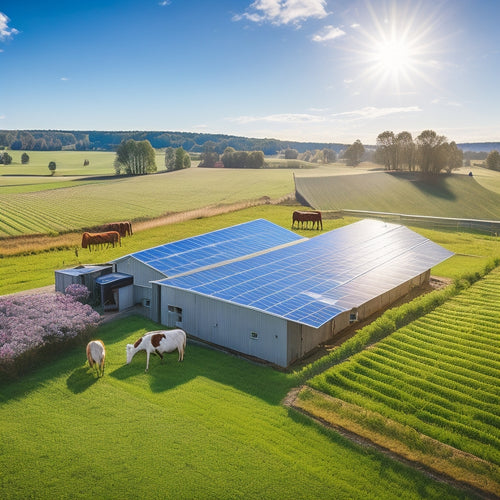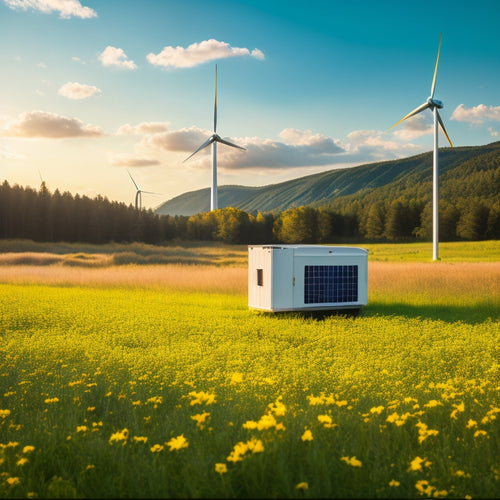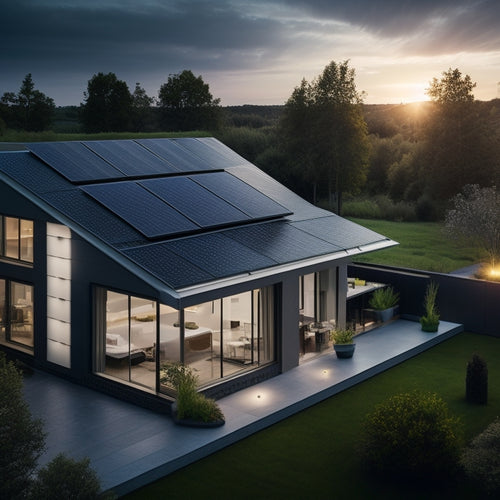
Optimizing Energy Efficiency With Monocrystalline Panels
Share
To optimize energy efficiency with monocrystalline panels, focus on their superior efficiency ratings, often exceeding 20%. Analyze roof space, orientation, and shading to maximize output. These panels thrive in low light, enhancing performance during cloudy conditions where others might falter. Their advanced silicon structure guarantees durability, promising a lifespan of 25-40 years with minimal efficiency loss over time. While the initial investment is higher, the long-term savings on energy bills justify this choice. By understanding technical specifications and installation strategies, you can make informed decisions that maximize efficiency and returns. There's more to investigate about enhancing your solar setup.
At a Glance
- Choose high-efficiency monocrystalline panels, which convert up to 22% of sunlight into electricity, maximizing energy output in limited space.
- Assess roof orientation and perform shading analysis to minimize obstructions that could impact the panels' efficiency.
- Utilize panels with lower temperature coefficients to ensure better performance in high-temperature environments, optimizing energy production.
- Plan installations to account for future energy needs, allowing for potential expansions without compromising efficiency.
- Leverage advanced installation technologies for quicker setups, ensuring high-quality installations that enhance energy efficiency.
Higher Efficiency Ratings Available
When you consider monocrystalline panels, you'll notice they often boast higher efficiency ratings due to advanced technology that enhances energy capture.
This superior performance sets them apart from polycrystalline panels, which typically have lower efficiency rates.
Additionally, advanced technologies like high-efficiency solar cells can convert up to 22% of sunlight into electricity, further improving energy output.
Advanced Technology Benefits
Monocrystalline solar panels are at the forefront of energy innovation, providing impressive efficiency ratings that set them apart from other technologies. When you invest in these panels, you're not just opting for superior performance; you're also embracing advanced technology that maximizes your energy independence.
Their high efficiency means you can generate more power from a smaller surface area, which translates to significant savings on space and installation costs.
In terms of cost considerations, while the initial investment may be higher, the long-term savings on electricity bills make monocrystalline panels a wise choice. You'll notice reduced utility expenses, allowing you to redirect funds toward other pursuits that enhance your freedom.
Moreover, installation practices for monocrystalline panels are increasingly refined, leading to quicker setups without compromising quality. As technology advances, the integration process becomes smoother, enabling you to utilize solar energy with minimal disruption.
Ultimately, the advanced technology benefits of monocrystalline panels provide you with the efficiency and reliability necessary to take control of your energy future. By choosing these panels, you're not just adopting a solar solution; you're making a strategic decision for sustainable living.
Comparison With Polycrystalline Panels
In the domain of solar energy solutions, the comparison between monocrystalline and polycrystalline panels reveals significant differences in efficiency ratings. Monocrystalline panels typically boast higher efficiency, often exceeding 20%, due to their single-crystal structure that allows for better electron movement. This translates to more power generation in smaller spaces, which is vital if you're limited on roof area.
When considering cost, monocrystalline panels generally come with a higher upfront investment. However, their superior performance can lead to greater long-term savings on energy bills, making them a worthwhile consideration for those seeking freedom from high energy costs.
On the other hand, polycrystalline panels, while less efficient, are more affordable initially, which can appeal to budget-conscious consumers.
Aesthetic appeal is another factor to weigh. Monocrystalline panels often have a sleek, uniform appearance that many find visually attractive, enhancing the overall look of your property. In contrast, polycrystalline panels can appear more fragmented.
Ultimately, the choice hinges on your specific needs, balancing efficiency, cost considerations, and aesthetic preferences to optimize your energy efficiency.
Longer Lifespan Compared to Others
When you choose monocrystalline panels, you're investing in durability that withstands harsh environmental conditions.
Their sturdy construction guarantees a longer lifespan, often backed by extensive warranty assurance.
Additionally, these panels are known for their high-efficiency rates, converting sunlight into electricity effectively, which contributes to significant long-term savings on energy bills.
This longevity not only enhances energy efficiency but also maximizes your return on investment over time.
Durability Under Harsh Conditions
Over the years, advancements in solar technology have highlighted the exceptional durability of monocrystalline panels, especially under harsh environmental conditions. Their design incorporates high-quality silicon, which contributes to outstanding panel resilience against extreme weather.
Unlike other types, monocrystalline panels undergo rigorous testing, guaranteeing they can withstand not just high winds but also heavy snow loads and intense heat.
You'll find that these panels maintain functionality even during significant temperature fluctuations, which can often lead to performance degradation in less durable alternatives. The sturdy construction and superior materials used in monocrystalline panels allow them to resist micro-cracking and other forms of physical damage that can arise from environmental stressors.
When you invest in monocrystalline panels, you're choosing a solution designed for longevity and reliability. The ability to perform efficiently under challenging conditions means you'll enjoy consistent energy production, enabling your energy independence.
Warranty Assurance and Longevity
Choosing monocrystalline panels not only enhances energy efficiency but also guarantees outstanding warranty assurance and longevity. When you invest in these advanced solar solutions, you're opting for technology that often outlasts alternative options. The longevity factors of monocrystalline panels include superior materials and efficient design, translating into longer life spans and strong performance.
Here's a comparative overview of warranty coverage and longevity:
| Panel Type | Average Warranty (Years) | Expected Lifespan (Years) |
|---|---|---|
| Monocrystalline | 25-30 | 25-40 |
| Polycrystalline | 20-25 | 20-30 |
| Thin-Film | 10-15 | 10-20 |
With warranties that frequently extend beyond 25 years, monocrystalline panels provide you with a sense of security and confidence in your investment. Their resilience to environmental stressors further enhances their longevity, ensuring that you'll reap the benefits for decades. When you choose monocrystalline panels, you're not just buying energy efficiency; you're securing peace of mind for the long haul.
Technical Specifications Overview
To maximize your investment in monocrystalline panels, understanding their technical specifications is essential.
These panels typically have high efficiency ratings, often exceeding 20%, which means they convert more sunlight into usable energy compared to other types.
The temperature coefficient reveals their performance under varying thermal conditions, indicating how much efficiency decreases as temperatures rise.
Efficiency Ratings Explained
Understanding efficiency ratings is vital when evaluating monocrystalline solar panels, as these metrics directly influence energy output and overall system performance.
You'll encounter efficiency ratings expressed as a percentage, representing the portion of sunlight converted into usable electricity. Higher ratings indicate better energy conversion, which is essential for maximizing your investment and minimizing space requirements.
Monocrystalline panels typically exhibit efficiency ratings between 15% and 22%, with top-tier models reaching even higher. This superior material efficiency stems from the high-purity silicon used in their construction, allowing them to harvest more energy from the same amount of sunlight compared to other panel types.
When evaluating efficiency, don't just look at the numbers; consider how these ratings translate into real-world performance.
For instance, a panel with a lower efficiency rating may still be effective in specific conditions or installations, while a higher-rated panel can greatly reduce your energy bills over time.
Temperature Coefficient Importance
Evaluating the temperature coefficient of monocrystalline panels is vital for predicting their performance in varying climatic conditions. This coefficient quantifies how much a panel's efficiency varies with temperature, offering you essential observations into its behavior under different environmental stresses. A lower temperature coefficient indicates better performance in high-heat scenarios, minimizing efficiency variation as temperatures rise.
Understanding the temperature impact on energy output is significant, especially if you live in regions with extreme weather. For example, if your panels have a temperature coefficient of -0.3% per degree Celsius, you can expect about a 3% drop in efficiency when temperatures increase by 10 degrees. This knowledge allows you to refine your system's placement and operation.
Additionally, considering the temperature coefficient helps you compare different monocrystalline panels, guiding your investment choices. By selecting panels with superior thermal performance, you can achieve greater energy yields, enhancing your energy independence.
Ultimately, grasping the significance of the temperature coefficient enables you to make informed decisions, ensuring your solar system delivers ideal performance year-round. Adopt this freedom to utilize solar energy efficiently, regardless of the climate challenges you face.
Selecting Based on Installation Space
When optimizing energy efficiency, evaluating your available roof space is vital for effective installation of monocrystalline panels.
Choosing high-efficiency panels can yield significant energy output, particularly in limited spaces where maximizing every watt is fundamental.
You'll need to take into account various panel size options to maximize energy output while ensuring a suitable fit.
Assess Available Roof Space
Before diving into the installation of monocrystalline solar panels, you must assess your available roof space carefully.
Start by evaluating your roof orientation. Ideally, a south-facing roof maximizes sunlight exposure, enhancing energy production. However, east or west orientations can also be effective, depending on your specific energy needs.
Next, conduct a thorough shading analysis. Identify any obstructions—like trees, chimneys, or neighboring buildings—that might cast shadows on your panels throughout the day. Shading can considerably diminish the efficiency of your solar system, so consider whether trimming foliage or adjusting panel placement is feasible.
Measure the dimensions of your roof, as well as the pitch and material. Flat roofs may require ballast systems, while sloped roofs often facilitate standard mounting options.
Be mindful of any local regulations or building codes that could impact your installation.
Consider Panel Size Options
In selecting the right monocrystalline panel size, it's crucial to align your choices with your available installation space.
Start by evaluating the panel dimensions that fit within your designated area while maximizing energy output. Keep in mind that larger panels generally produce more power but require more space, so you'll need to balance these factors carefully.
Consider installation considerations such as roof orientation, shading from nearby structures, and accessibility for maintenance. If your space is limited, opting for smaller panels may be more advantageous, allowing you to arrange them efficiently without sacrificing too much energy production.
Moreover, think about the potential for future expansion. If you foresee needing additional capacity later, choosing panels that fit your current space but offer scalability can provide you with the freedom to grow your energy system seamlessly.
Ultimately, the right panel size enables you to optimize energy efficiency while maintaining flexibility in your solar setup.
Make informed decisions based on your unique circumstances, ensuring you utilize the full potential of your monocrystalline panels for sustainable energy independence.
Superior Performance in Low Light
When considering energy efficiency, you'll find that monocrystalline panels excel in low light conditions.
Their advanced cell technology guarantees higher conversion efficiency, allowing you to utilize more energy even on overcast days or during dawn and dusk.
This capability not only maximizes your energy output but also enhances the overall performance of your solar system.
Low Light Conversion Efficiency
Monocrystalline panels excel in low light conditions, offering superior performance that greatly improves energy conversion efficiency. Their unique crystalline structure allows for better electron mobility, which translates into enhanced low light performance. This means you can utilize solar energy even when sunlight is limited, such as during cloudy days or early mornings.
When you face shading impacts from nearby trees or buildings, monocrystalline panels still maintain a competitive edge. They've a higher tolerance for partial shading, which minimizes the loss of energy output. Unlike traditional panels that suffer drastic efficiency drops under similar conditions, these panels continue to generate power, guaranteeing you maximize your energy independence.
Moreover, the advanced manufacturing techniques used in crafting monocrystalline cells assure a higher purity silicon content, which directly contributes to their exceptional performance in low light scenarios.
You'll find that investing in these panels not only optimizes your energy efficiency but also enhances the overall reliability of your solar energy system.
With monocrystalline panels, you can confidently adopt a greener lifestyle, knowing you're making the most of every ray of sunlight, regardless of the weather conditions.
Frequently Asked Questions
What Is the Cost Difference Between Monocrystalline and Other Solar Panels?
When you look at the cost comparison, monocrystalline panels typically have a higher upfront price than polycrystalline options. However, price trends indicate long-term savings through efficiency, making them a worthwhile investment for energy independence.
Are Monocrystalline Panels Recyclable at the End of Their Lifespan?
Can you envision a universe where your solar panels help the planet even after they're done? Monocrystalline panels are recyclable, minimizing their environmental impact through a well-structured recycling process that recovers precious materials for future use.
How Do Weather Conditions Affect Monocrystalline Panel Performance?
Weather conditions greatly impact monocrystalline panel performance. Extreme temperatures can reduce efficiency, while high humidity levels may lead to moisture buildup. You'll want to take these factors into account for ideal energy production and longevity of your panels.
Can Monocrystalline Panels Work Efficiently in Cloudy Climates?
In a dance with clouds, monocrystalline panels still shine. Their cloudy performance can be surprisingly efficient, utilizing diffuse sunlight. While lower than sunny days, their panel efficiency keeps your energy hopes alive—even in overcast skies.
What Maintenance Is Required for Monocrystalline Solar Panels?
To maintain your monocrystalline solar panels, focus on regular panel cleaning to maximize efficiency. Follow installation tips like proper orientation and shading analysis to guarantee peak performance and longevity, giving you the freedom to utilize solar energy effectively.
Explore More
In today's energy environment, choosing monocrystalline panels is like finding a diamond in the rough. With their higher efficiency ratings, longer lifespan, and exceptional performance in low light, these panels not only maximize your energy output but also offer lasting value. By carefully selecting based on your installation space, you can utilize the full potential of solar technology. Embracing these innovations in energy efficiency positions you at the forefront of sustainable energy solutions.
Related Posts
-

What Do I Need to Know About Farm Solar Panels
When considering farm solar panels, you need to assess costs, benefits, and technical specifics. Initial investment c...
-

Sustainable and Eco-Friendly Generators for a Reduced Carbon Footprint
Sustainable and eco-friendly generators are perfect for cutting your carbon footprint and increasing energy efficienc...
-

Home Solar Battery
You're opting for a home solar battery that allows you to utilize the power of the sun during the day and use it at n...


